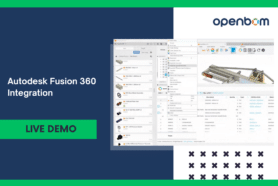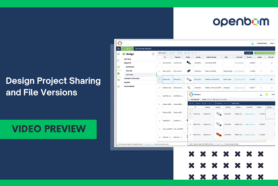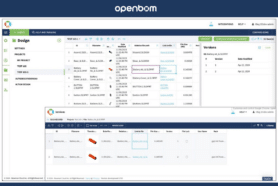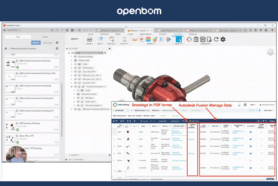
One of the biggest dilemmas in the traditional PDM and PLM software world is related to relationships between design and Bill of Materials management systems. In a practical sense, these are relationships between CAD and CAD data management (PDM) from one side and engineering and manufacturing planning systems (PLM and ERP systems) managing a variety of Bill of Materials forms. Some PLM companies don’t like to talk about BOM and speak about “Product Structure”, but this is a competitive way to introduce engineering BOM and an attempt to control ERP and manufacturing systems. This is a brutal reality of engineering and manufacturing software for the last 25-30 years. Whoever owns the data can control everything else in a company.
Lionel Grealou wrote a great article describing 2 main forms of CAD-BOM relationships. Check it here CAD-BOM Alignment: CAD-Driven BOM vs BOM-Driven CAD.
My favorite passage from his article:
Expecting engineers to work in a BOM-driven CAD context is often utopian in the early stages of the product development lifecycle. As the product matures and manufacturing “takes over” from engineering, parts are selected for a particular product configuration by defining features and timing.
Engineers and project engineers require “simpler” product structures to navigate through instance paths which can be retained for a given part regardless of changes to BOM lines of usage. They need to experiment and test design options without the burden of advanced change management constraints.
After the creation of the part structure, Engineers can add non-geometric information, as well as options and variants assigned to the existing designs. Simulation parameters and results, issues and design review mark-up can be added to the data set for traceability. Change request and notices can then be tracked at the EBOM level and synchronized with the MBOM at different maturity gates. The EBOM is then aligned with the MBOM at multiple touch points, and more regularly when transitioning from development to manufacturing. The BOM mastership is therefore expected to transition from the EBOM to MBOM as soon as the product moves into industrialization and start-of-production (SOP). Based on the manufacturing or assembly complexity, there is also a process BOM which sits between the EBOM and the MBOM to simulate and optimize how the product is produced.
So, what is the solution? And is there a solution? Another Lionel’s article – Single Enterprise BOM: Utopia vs Dystopia can give you some sense of the reality in how powerpoints are different from realities you can find in many manufacturing companies.

At OpenBOM, we are experimenting with a new way to integrate systems and build a new and robust model to support the Product lifecycle, BOM management, software for quality management, which can be connected to the CAD system, but at the same time not mandatory and too constrained.Product development life cycles in OpenBOM enable organizations to integrate and coordinate their business processes on a robust foundation. We are hard at work building products and services to help product teams and engineers to experiment with the technologies. Let us know if you’re interested in learning more! Also OpenBOM CAD integration is designed to ground up to support native cloud and web environments. Let us know if you are interested in learning more!
There are two fundamental elements to support this model:
1. Real-time collaborative BOM change model
OpenBOM change model was designed to support merges of changes in BOM that can happen simultaneously. Think about changing the number of part instances and changes of additional part parameters such as reference designator, description, manufacturer or cost. Multiple users can simultaneously edit BOM without being constrained. It has huge advantages. One of them that can share data in real-time (learn more about it here – OpenBOM real-time collaboration) and second application services, such as CAD integration services can send changes to BOM at any time.
2. Integration online services and full change history
OpenBOM CAD integration services are capable to send changes to BOM in asynchronous using RESTFull interface and linking to Bill of Materials data using persistent online links in such a way all engineering and design data can be referenced, but at the same time not constraining BOM changes. Combined with full change history and support for baselines (immutable revisions) can be used to track everything that was done in the past.
The advantage of this model, as we learned it from working with many customers is to provide a much more flexible and reliable system of dependencies between CAD and BOM. At the same time, change history will preserve full traceability of data.
Another key benefit of OpenBOM CAD integration services is that all of them are designed for cloud-based integration and can be used for both desktop to cloud and cloud to cloud integration scenarios.
Check a few videos demonstrating how OpenBOM can be integrated with desktop CAD systems (eg. Solidworks) as well as with cloud-based systems (eg. Onshape). Even more, the same integration system can be used in hybrid integration scenarios with a system running on the desktop with full sync to the cloud (eg. Autodesk Fusion).
Check for more videos on OpenBOM YouTube channel
Conclusion
At OpenBOM we discover a new way to integrate CAD and downstream engineering system by providing RESTful integration between CAD system and Bill of Materials management service that can run in public, private or hybrid cloud environment. OpenBOM integrations allows flexible linking of data and full history traceability.
Want to learn more about OpenBOM. Many of OpenBOM CAD integrations are included in OpenBOM FREE user subscription. Check more here – OpenBOM subscription pricing and Integrations.
Best, Oleg
P.S. Let’s get to know each other better. If you live in the Greater Boston area, I invite you for a coffee together (coffee is on me). If not nearby, let’s have a virtual coffee session — I will figure out how to send you a real coffee.
Want to learn more about PLM? Check out my Beyond PLM blog and PLM Book website.
Image credit – Lionel Grealou blog
Join our newsletter to receive a weekly portion of news, articles, and tips about OpenBOM and our community.









